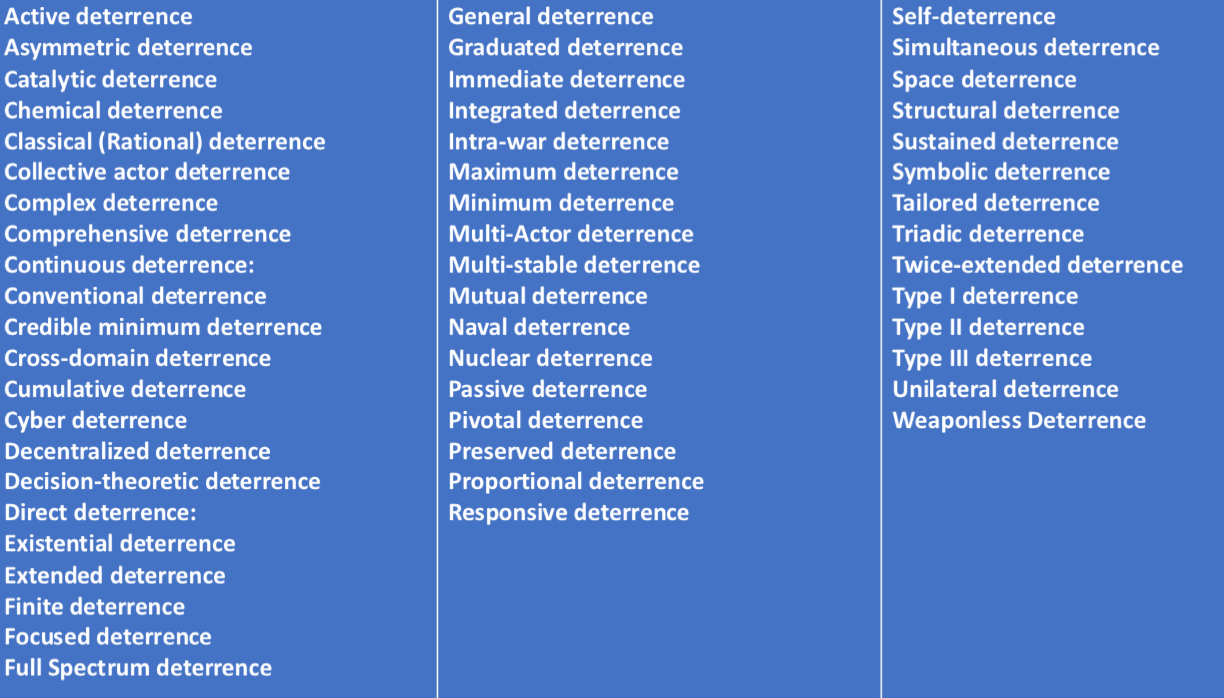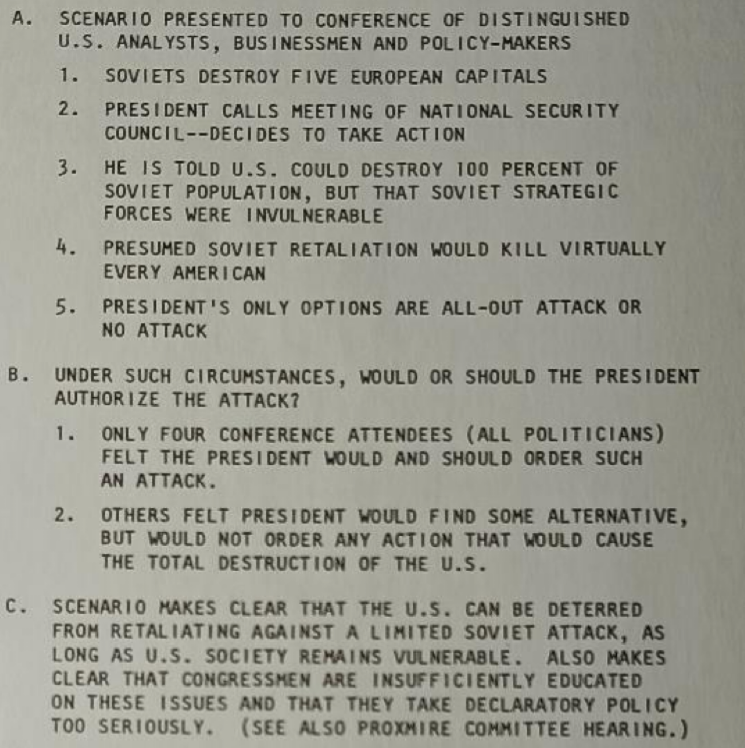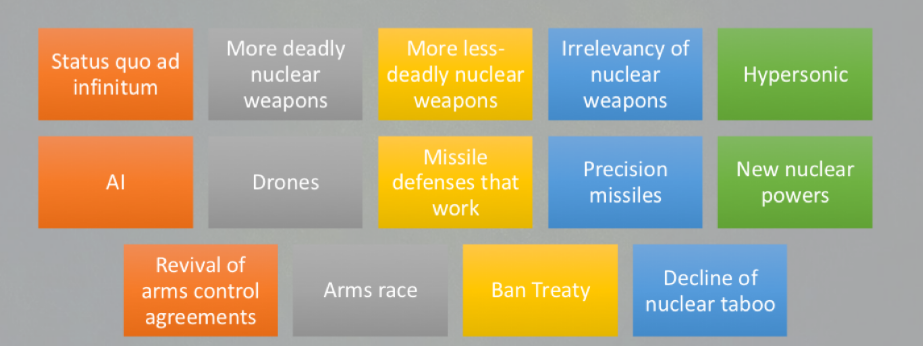L6: nuclear weapons and deterrence
1/26
There's no tags or description
Looks like no tags are added yet.
Name | Mastery | Learn | Test | Matching | Spaced |
|---|
No study sessions yet.
27 Terms
Doomsday weapon
Doomsday weapon is supposed to deter, if you don’t tell anyone, it wont deter anyone
Technologically possible to build one, why hasn’t any nation built one?
No politician would agree to build one even if there is the tiniest chance something could go wrong —> not worth the risk
If everyone has one it loses its deterrence
Not credible to build one
If nuclear weapons are so small that they can cause little civilian damage, why haven’t they been used?
Nuclear taboo
Keeps people from using them, shamed internationally for using them
If start using them, they might become normalized
There are certain weapons that have been deemed unacceptable → bio, chemical, nuclear
Nuclear peace theory
→ nuclear powers will not go to war with each other
Giving more countries nuclear weapons might be good for peace bc no one will want to attack them
are nuclear weapons ethical?
the nuclear powers
US (1945)
Soviet Union (1949)
Great Britain (1952)
France (1960)
China (1964)
India (1974)
Pakistan (1998)
North Korea (2006)
Israel?
South Africa?
→ developed some in 80s, destroyed with the end of apartheid
Why don’t more countries have nuclear weapons?
Need the scientific infrastructure in order to build the weapons —> takes a long time to build up
Might be able to build the actual bomb but building a missile that will actually be able to deliver the bomb takes longer to develop
nuclear warhead inventories through time
After Cold War: numbers went down
Now: going up again
Around 2000 the assumption was that the nuclear weapons would continue to decline, however they have started to go up agin
Deterrence: a short history
From Adam and Eve to early Cold War
Adam and Eve: first deterrence failure (by God)
don’t eat the apple, they ate the apple
Cold War 'coming of age', 'key concept for the understanding of the strategy and diplomacy' of the period
Post-Cold War 'semi-retirement'
Post-Crimea: back in fashion
Deterrence
1. "the persuasion of one's opponent that the costs and/or risks of a given course of action he might take outweigh its benefits"
2. "the prevention of action by the existence of a credible threat of unacceptable counteraction and/or belief that the cost of action outweighs the perceived benefits"
List of types of deterrence

General vs immediate deterrence
General: conveys a somewhat vague, broad, continuous threat of retaliation for any future attack (e.g. NATO Article 5)
Peace time deterrence
Immediate: threatening retaliation when an attack looms, or as already occurred and the victim wants to deter its continuation
Threat/aggression time deterrence
Post war immediate = try to deter certain things within the war, like deter the use of specific types of weapons
Punishment
threats to impost costs through retaliation that may be unrelated to the aggression itself. Rather than focusing on the denial of local objectives, it seeks to raise the cost of aggression- even if successful - by threatening other consequences
Denial
strategies that seek to deter an action by making it infeasible or unlikely to succeed, thus denying a potential aggressor confidence in attaining its objectives - deploying sufficient local military forces to defeat an invasion, for example
Direct vs Extended
Direct: trying to deter an attack on homeland/ yourself (US during Cold War)
Extend: to allies → US to NATO allies

3 types
Type 1: Direct attack (US vs USSR)
Type 2: Extended deterrence challenge (NATO vs
Warsaw Pact)
Type 3: Peripheral conflict (Korea, Vietnam)
Deterrence success
What constitutes a successful case?
Difficult to prove
NATO in Europe kept Eastern Europe from soviet → nuclear deterrence worked (hard to prove)
Problem of explaining a non-event
How to measure whether a threat had an effect on an adversary's behavior?
To measure deterrence:
Evidence that illustrates challengers intent and defenders deterrent attempt
BUT challengers intent difficult to discern
Are attacks that do not occur every day examples of deterrence success?
What about countless reasons other than threats (self-deterrence)?
Credibility
Problem of incomplete information
Interests at stake
Ex. Is Ukraine enough?
How to communicate commitment to fight?
Reputation/'cumulative deterrence'
Doomsday device —> not credible to build one
don’t want to commit suicide
How do you make deterrence credible?
How do you convince Russia that the US would go and defend their allies if Russia invaded
Is Putin interest of Ukraine enough to stake nuclear war?
Madman Theory
does it pay to act crazy?
The game of chicken
What if one of the guys is seen drinking before getting in the car → he isn’t control of his senses, he wont swerve
Changing/altering a variable like that can effect how credible your threat is → angry/crazy
Don’t let the genie out of the bottle
Keep nuclear weapons in bottle
Korea ex.
Used nuclear weapons against japan a few years ago, don’t want to use nuclear weapons against Asian people again
Bad publicity
Once you start using them, soviets are going to start using them
Whatever your goal is, using nuclear weapons to reach them just isn’t worth it
Nuclear deterrence options
Maximum / 'overkill' - Counterforce + Countervalue
US, Russia will attack cities and military targets→ counterforce + counter value
Counterforce = military
Minimum - Countervalue only
UK, France will only attack cities → only counter value
Counter value = civilian
Triad?
No first use
China and India are the only ones that have this
Mini-nukes
Need to have redundancy —> have enough left in order to deter them to attack back
Nuclear Triad
Nuclear submarines are the most likely to survive a strike by another country, guaranteeing the United States the ability to strike back.
Build certain nuclear weapons for certain things → give you an edge
Are able to strike back in different ways
ICBMs can be launched quickly if necessary.
Strategic bombers armed with penetrating cruise missiles can be deployed and recalled more easily.
Bombers, Missiles, Submarines
Tends to be the order when we think of how a nuclear war would be waged
Single Integrated Operation Plan 1969
Ban all communist countries into a block
If Russia attacked western Germany, the plan would be to not only strike Russia, but also China and the whole of Eastern Europe
Cold War: ethnic nuclear war plan
just kill the Russians, try and leave the rest of Eastern Europe alone
Oplan 8010-08
Strategic Deterrence and Global Strike
Directed against six adversaries.
Probably Russia, China, North Korea, Iran, Syria and 9/11-type WMD scenario
Half do not have nuclear weapons and four of them are NPT members
Includes four types of nuclear attack options:
Basic Attack Options (BAOs)
Selective Attack Options (SAOs)
Emergency Response Options (EROs)
Directed/Adaptive Planning Capability Options
There are no longer Major Attack Options (MAOs) in the strategic war plan
NATO nuclear deterrence timeline
1949: First Strategic Concept: to use all weapons against overwhelming Soviet conventional superiority
1952: Lisbon Force Goals: 96 NATO divisions ready in 90 days
by 1954 (actual peacetime total in 1954: 16)
1953: "New Look"
1954: MC 48: tactical atomic use to "prevent rapid overrunning"
1955: FRG joins NATO, US atomic weapons in FRG
1957: MC 14/2 massive retaliation w/ caveats
1962: Athens Guidelines, Cuban Missile Crisis
1968: MC 14/3 Flexible Response
1969 to end of Cold War: how to implement flexible response
1970s: NATO nuclear warheads in W. Europe reach maximum of 7k
1991 to present:
no clear articulation of NATO nuclear policy
NATO nuclear policy in limbo despite 2014/2022
reduction in warhead numbers (200? in 2010,
100? in 2025)focus on warhead and delivery capability modernization
India-Pakistan crisis - elements of restraint
Tit for tat conflicts
1999
2001-2002
2008
2016
2019
The next nuclear powers?
Iran, not quite crossed nuclear threshold —> will the cross it
If Iran goes, Saudi Arabia and Turkey will follow
The future of nuclear weapons
